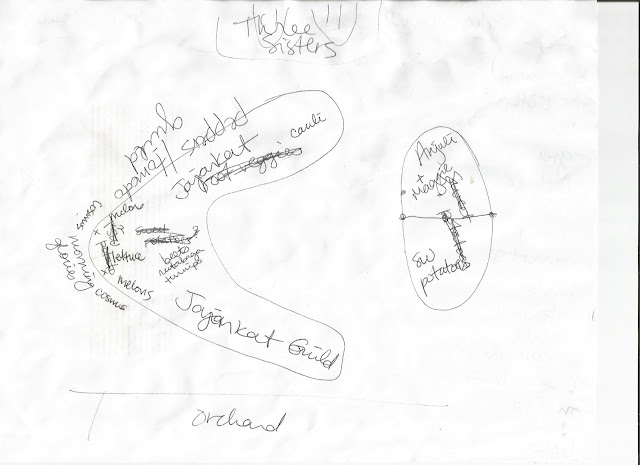We're trying a number of different gardening hypotheses. These ideas are inspired by Gaia's Garden chapter 8 by Tony Hemenway and Paula Westmoreland's Natural Capital Plant Database. Seeds thanks to Seed Savers Exchange, West Coast Seeds, Territorial Seeds, and Ritcher's Herbs.
S
N
First, the Three Sisters- a classic. I read and followed Hemenway's instructions except that I planted everything at once, no staggered planting. All the seeds are SSE unless otherwise noted. Three corns- Mandan Bride (cornmeal), Black Aztec (cornmeal), and Two Inch Strawberry (popcorn). Three beans, all pole, with inoculant- Good Mother Stallard (dry), Cherokee Trail of Tears (snap or dry), and Hidatsa Shield Figure (dry). Three squash- Table Queen, Waltham Butternut, Honey Boat Delicata (WCS). We put them in the new hugel-inspired raised bed made of logs which Dave installed with his tractor last weekend. Manure from Johnsons. Dirt from pile saved from when the foundation was dug. Mulched thoroughly with our own wood chips. Clover around bed and on paths to suppress weeds.
Second, the oval hugel- an experiment in two parts. Anjali took the southern facing side of this hugel and I took the northern. I planted about 20 sweet potato plants, and I can't remember where I ordered them from. I couldn't find any info on sweet potatoes and planting with other plants so I decided to make this my one monoculture this year. My whole section of the hugel is covered in sweet potato plants. Hugel is constructed of logs, manure, dirt, and was well mulched with leaves and then covered by cardboard during the winter to prevent spring erosion. Virtually no weeds.
Third, Tomato/Pepper Guild- this one is inspired by the Natural Capital Plant Database and includes tomatoes, sweet peppers, basil, and summer savory (Richters). The tomatoes and peppers are plants from SSE. They arrived in perfect condition and stayed that way until planted. Peppers include: Bull Nose Bell, Jimmy Nardello's, King of the North, Mini Chocolate, Mini Red, Mini Yellow, Orange, and Tolli's Sweet Italian. Tomatoes include: Amish Paste, Brandywine, Cherokee Purple, Dester, Gold Medal, and Italian Heirloom. Basils: Holy (good germination, WCS), Cinnamon (best germination, SSE), Lime (SSE), and Mrs. Burn's Lemon (SSE). This is on the south facing slope of the first and tallest hugel Tim built out of logs and lots of manure. We covered it with boards to prevent erosion which we removed this spring and now it's covered with wood chip mulch.
Brief aside. I don't care for basil. When I was pregnant with Anjali, I ate basil and noodles during the early-months-queasies and couldn't eat basil for years, although eventually I liked it again. Then I got pregnant with Mark and ate fresh basil tomato pizza early on. Haven't really gotten back to it yet. So why, you may ask, are you planting basil? Well, hope springs eternal. Maybe this year I'll like basil. And why four? Well, because I learn by comparing and contrasting. I want to be able to see which ones grow better, taste better, last longer. More than just a yes or no, I want to compare. So in most things, I got several kinds, sometimes up to 8 kinds of the same vegetable to see what works and what I like.
Jajarkat-Inspired Polyculture Garden- this one is inspired by Hemenway's description of a polyculture developed in Jajarkat, Nepal. Polycultures are many plants cultivated together and then harvested individually as they mature. I loosely followed his instructions. I did start the cauliflower, broccoli, and cabbage inside but I also planted all the beans today rather than waiting. Where there was mulch, we planted inside-started sprouts. Where the ground was bear, we weeded and planted mostly seeds along with a few sprouts. Where there were more weeds, I tried to plant more things I'd recognize easily like Rainbow Chard or onions or carrots. On the bottom of the V, we planted deep root crops like turnips and parsnips away from the cauliflower on the northwest end as these inhibit each others' growth. Otherwise, everything was seeded together. His explanations are excellent so I encourage you to read Chapter 8 of Gaia's Garden for more details. This is the largest annual garden. Here is a list of the 40 types of seeds I recorded. They are SSE unless otherwise noted.
Anise
Leek, Blue Solaise
Carrots, Rainbow Blend, WCS
Rutabaga, Joan
Watermelon, Cream of Saskatchewan
Beet blend, WCS
Parsnips, Cobham Improved Marrow, TSC
Turnip, Purple Top White Globe
Parsnips, Harris Model, WCS
Bean, Hidastsa Red, bush, dry
Bean, Empress, bush, snap
Bean, Arikara Yellow, bush, dry
Purslane, Tall Green, WCS
Swiss Chard, Five Color Silverbeet
Radish, Easter Egg Blend, WCS
Sage, White
Broccoli, Calabrese
Cauliflower, Multi-color blend, WCS (I'm big into multi-colored)
Broccoli, Hybrid blend, WCS (I'm hoping the open pollinated ones will work as well as these)
Pac Choi, Ching Chiang, WCS
Cabbage, Mammoth Red Rock
Cabbage, Premium Late Flat Dutch
Broccoli, Romanesco
Heriloom Lettuce Collection- Forelenschluss, Bronze Arowhead, Amish Deer Tongue, Red Velvet, Crisp Mint, Flame
Onions, Spanish Red and Cipollinni
The Prow Garden is the outside east facing slope of the two big hugels. I planted meaningful seeds here since this is what people will see as they drive up- morning glories from our old house, orange cosmos from Emily and George Reisdorf's house, melon seeds we saved from our favorite La Finca CSA melons last year, along with seeds from a scrumptious Gardens of Eagen yellow melon. Seeds from the past to bless us into our future.
We're trying raised beds and hugels, polyculture and monoculture, mulched and thickly seeded, seeds and sprouts. Just like our seeds, we're going to be comparing and contrasting our gardening styles. We'll keep you posted.





No comments:
Post a Comment